![]()
![]()
![]()
Use LEFT and RIGHT arrow keys to navigate between flashcards;
Use UP and DOWN arrow keys to flip the card;
H to show hint;
A reads text to speech;
64 Cards in this Set
- Front
- Back

|
OCTOPUS FLASK Minoan Civilization Ceramic Painted with marine life Celebration of Minoan Maritime skill Painting designed to flow with the shape of the vessel, face centered on crest |
|

|
HARVESTOR RHYTON Minoan Civilization Carved steatite 4.5" tall Rhyton: vessel used for pouring Emotional marching to music Thin figures, ribs visible May be harvest festival, religious procession, etc. |
|
|
Geometric Period |
900-700 BC |
|
|
Orientalizing Period |
700-600BC |
|
|
Archaic Period |
600-480BC |
|
|
Early Classical Period |
480-450BC |
|
|
High Classical Period |
450-400BC |
|
|
Late Classical Period |
400-323BC |
|
|
Hellenistic Period |
323-30BC |
|
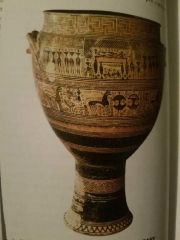
|
The Hirschfeld Workshop FUNEREARY KRATOR C.750BC The Geometric Period 42.5" Ceramic Athens Krator: used to mix water and wine This one is ceremonial, grave marker Belonged to military officer 2 registers of narrative scenes: 1st row- funeral with professional mourners; 2nd row- battle of troy, characters are labeled Holes for drainage in bottom, so the dead can drink the wine Painted |
|
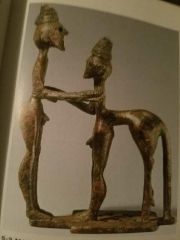
|
MAN AND CENTAUR The Geometric Period Olympia Bronze 4.5" tall Triangular torso Probably Herakles with Nessus Sculpture used for offerings Centaurs are usually in battles for a specific reason |
|
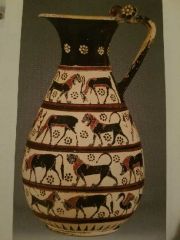
|
OLPE The Orientalizing Period Ceramic with Black figure decoration 13" tall Corinth Not geometric Animals: Panthers, goats, deer, bulls, boars, and swans Clay is buttery cream color because of high calcium content |
|
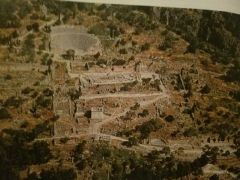
|
SANCTUARY OF APOLLO The Archaic Period Delphi Greece Amphitheater Oracle: place where Apollo communicated with humans thru Pythia Kings consulted Pythia about going to war Site of Pythian Games |
|
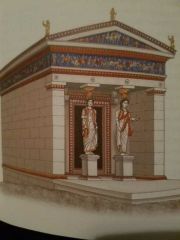
|
TREASURY OF THE SIPHIANS The Archaic Period Built by residents of Siphnos Caryatids: Columns in the form of women in flow gowns on top of pedestals with elaborate capitals on their heads Siphians were very rich Polychromed Ionic order |
|
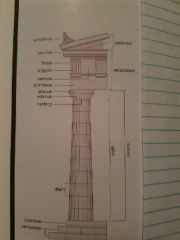
|
Doric Order |
|
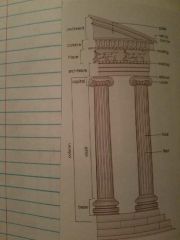
|
Ionic Order |
|
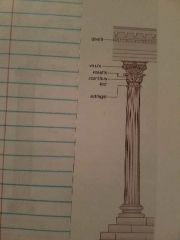
|
Corinthian Order |
|
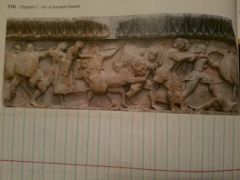
|
BATTLE BETWEEN THE GODS AND THE GIANTS The Archaic Period Frieze on Treasury of Siphians Relief carving on marble, undercut to create more definition and show more shadows 26" |
|
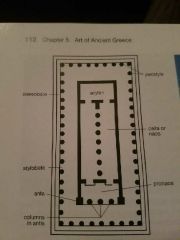
|
PLAN OF THE TEMPLE OF HERA I, POSEIDONIA The Archaic Period One of the 1st large scale buildings |
|
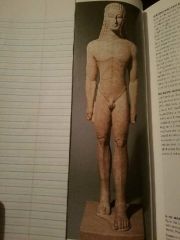
|
METROPOLITAN KOUROS C.600-590BC The Archaic Period Attica, Greece Marble 6'4" Mimics stance of Egyptian sculptures Used for grave markers/temple dedication Some are related to true people Nude represents Greek ideals
|
|
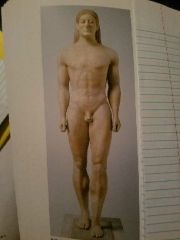
|
ANAVYSOS KOUROS The Archaic Period Cemetery at Anavysos, near Athens Marble with remnants of paint 6'4" More defined muscles Rounded athletic body Archaic smile Symbolic Grave monument for warrior |
|

|
PEPLOS KORE The Archaic Period Kore: female figure Clothed Grave markers, temple dedication Akropolis, Athens May have been goddess Missing hand could hold clues about her attributes
|
|
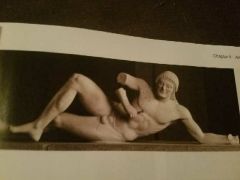
|
DYING WARRIOR C. 500-490 BC or 470's The Archaic Period Marble, painted, bronze accessories 5'6" long West pediment of Temple of Aphaia, Aegina Conceptual to make it visible Nude Life size Smiling Holding himself on one elbow |
|
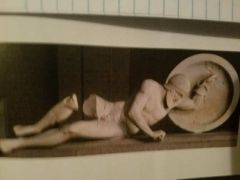
|
DYING WARRIOR C.490-480BC The Archaic Period East Pediment of Temple of Aphaia, Aegina Traces of Archaic smile More realistic Looks like soldier is falling |
|
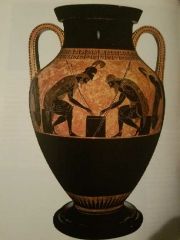
|
AJAX AND ACHILLES PLAYING A GAME The Archaic period Musei Vaticani, Rome Ceramic Black figure Painted and potter Exakias 24" tall Scene holds tension Hierarchy in scale Black figure painting |
|
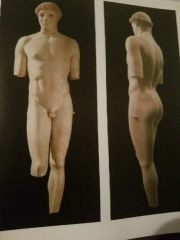
|
KRITOS BOY The Early Classical Period Akropolis, Athens Marble 3'10" Relaxed pose Soft round body Broad facial features Calm expression Contrapposto:counterweight stance |
|
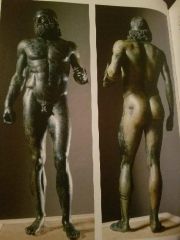
|
RIACE WARRIOR C. 475BC, 460-450 The Early Classical Period Bronze with bone and glass eyes, silver teeth, copper lips and nipples 6'9" Found in sea of Riace, Italy Contrapposto |
|
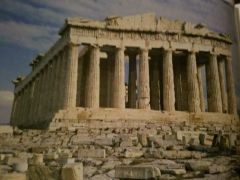
|
THE PARTHENON C. 447-432 BC The High Classical Period Athens Pantelic marble Pericles: politician that ordered the project to be rebuilt Phidias: brains; designer and contractor Iktinos: architect Kallilrates: architect Covenant between goddess and people Doric Undergoing major restoration since the 1970s |
|
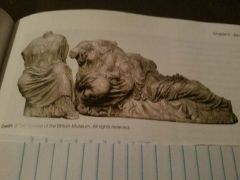
|
THREE GODDESSES C. 447-432BC The High Classical Period East Pediment of Aparthenon in Akropolis, Athens Wet cloth Naturalized, but also idealized Birth of Athena Hestia, Dione, and Aphrodite |
|

|
LAPITH FIGHTING A CENTAUR The High Classical Period Parthenon, Athens Made centaur believable Idealistic |
|
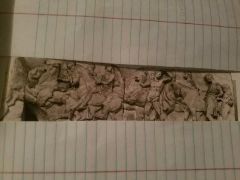
|
HORSEMEN The High Classical Period Ionic Frieze on the north side of Parthenon, Athens Marble 41.75" Controversial Panathenaic |
|
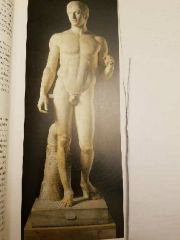
|
DORYPHOROS (SPEAR BEARER) The Early Classical Period Sculptor: Polykleitos Marble reconstruction of bronze sculpture Cannon: manifestation of theoretical math that explained the proportions of the human body |
|
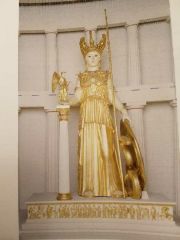
|
ATHENA PARTHENOS The High Classical Period Partgenon, Athens Gold and ivory Statue of Athena Shield in one hand, winged Nike in the other hand 35' tall Temple built around her Large dark space |
|
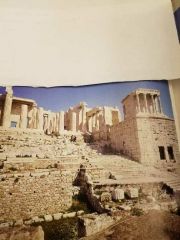
|
THE MONUMENTAL ENTRANCE TO THE AKROPOLIS, ATHENS The High Classical Period Olive tree Rock with Posidons trident marks Ancient altar from ancient king of Athens |
|
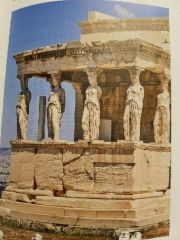
|
PORCH OF THE MAIDENS, ERECHTHEION The High Classical Period Akropolis, Athens Caryatids support ionic entablature Contrapposto Wet drapery |
|
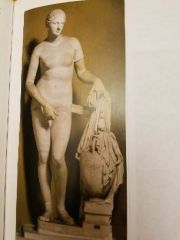
|
APHRODITE OF KNIDOS C. 350 BC The Late Classical Period Artist:Praxiteles Composite of two similar Roman copies after original Marble Nude female, scandalous Preparing to bathe |
|
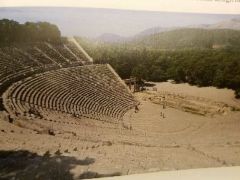
|
THE THEATER AT EPIDAUROS The Hellenistic Period Peloponnese, Greece Wonderful acoustics Carved into mountain Still has performances |
|
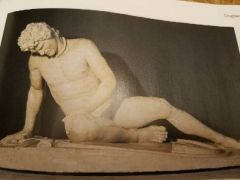
|
DYING GALLIC TRUMPETER The Hellenistic Period Found in Julius Caesar's garden in Rome Marble reconstruction of bronze 36.5" Fallen Celtic soldier Twisted necklace, torc, represented barbarian |
|

|
ALTAR FROM PERGAMON The Hellenistic Period Marble Messy Large scale sacrifice Relief sculpture Turkey |
|
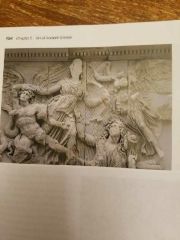
|
ATHENA ATTACKING THE GIANTS C. 175-150BC The Hellenistic Period Marble 7'7" Dramatic Emotional |
|
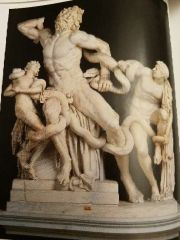
|
LAOCOÖN AND HIS SONS The Hellenistic Period Marble 8' Inspired by Hagesandros, Polydoros, and Athenodoros Part of large installation Fountain Twisting Anguish Laocoön punished for letting in wooden horse by him and his sons being attacked by sea serpents |
|
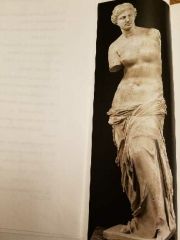
|
APHRODITE OF MELOS C.150-100 BC The Hellenistic Period Marble 6'8" Found on island of Melos Twisted torso Calm face and hairstyle, retro |
|
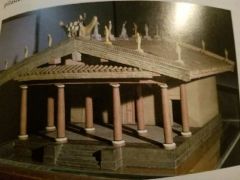
|
MODEL OF AN ETRUSCAN TEMPLE The Etruscans Statues on top Columns only in front Tuscan order |
|
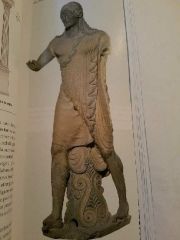
|
APOLLO The Etruscans Sculptor: Vulca Painted Tera cotta 5'10" From temple of Minerva, Portonaccio, Veil Archaic smile Clothed, unlike archaic Has movement, unlike rigidness of Archaic Hollow Energetic, intricate patterns, scrolls at bottom, rippled fabric , scrolls at bottom, rippled fabric |
|
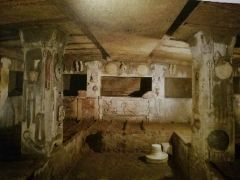
|
TOMB OF THE TRICLINIUM The Etruscans Tarquinia Greek vessels found here Couches, animals, etc. were carved to look like homes |
|
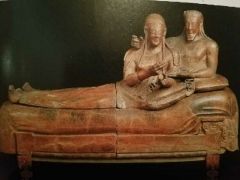
|
SARCOPHAGUS OF THE MARROED COUPLE The Etruscans Terra cotta 6'7" From Caverti Both probably held eggs Woman used to hold a bronze animal Mirrors were passed down to daughter, who then smashes the reflective side to release the mother's soul. Then the mirror was hurried with the mother |
|
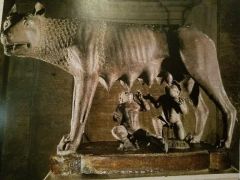
|
CAPITOLINE SHE-WOLF C.500BC or C. 800AD Rome Bronze 33.5" tall Boys underneath are Romulus and Remus, founders of Rome Boys added in middle ages When restored, it was found that the sculpture is probably a remake because it was not made in the Etruscan way. |
|
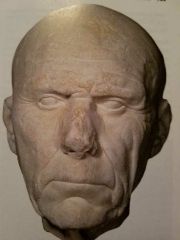
|
PORTRAIT HEAD OF AN ELDER The Roman Republic Verism: truth Showed age, age shows experience |
|
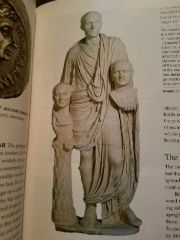
|
PATRICIAN CARRYING BUSTS OF HIS ANCESTORS The Roman Republic Marble 5'5" Rome Form of ancestor worship Busts often pre-carved with blank faces to speed up orders |
|
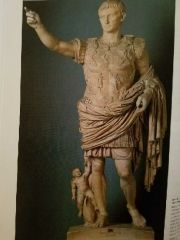
|
AUHUSTUS OF PRIMAPORTA The Early Empire Primaporta, near Rome Marble, originally painted Remake of Bronze Emperor Not Verism Contrapposto Hand out, "I have something important to say" Puto (cupid), cherub Descendant of Venus |
|
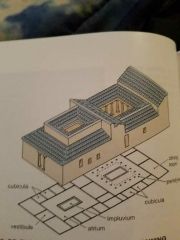
|
THE HOUSE OF THE SILVER WEDDING The Early Empire Designed around a courtyard for ventilation Roman villa, led to skyscrapers |
|
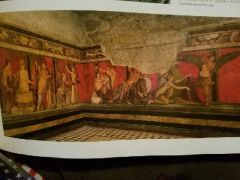
|
INITIATION RITES OF THE CULT OF BACCHUS, VILLA OF THE MYSTERIES The Early Empire Pompeii Wall painting Chiaroscuro, light and shadows gives depth The red in the picture is called "Pompeiian Red" Green stage continues across entire room |
|
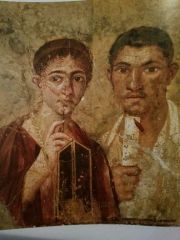
|
PO4TRAIT OF A MARRIED COUPLE The Early Empire Portrayed as serious He holds a scroll She has a stylus and dyptych Portrait shows education |
|
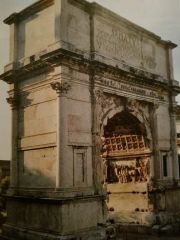
|
ARCH OF TITUS The Early Empire Rome Concrete and white marble People larger than background proportionately, allows for legibility Roman vaulting Barrel vault: tunnel, not good air flow or light Groin vault: criss cross barrel vault, allowed more air flow and light, used to create large complex structures , allowed more air flow and light, used to create large complex structures |
|
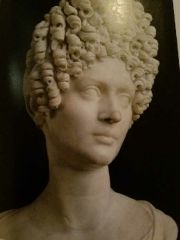
|
YOUNG FLAVIAN WOMAN The Early Empire Rome Marble 25" Smooth genuine looking flesh Highly personal features Intricate hair Clearly aristocrat, fierce face |
|
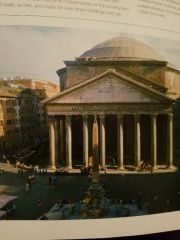
|
PANTHENON C 110 -28 CE Th High Imperial Art of Trajan and Hadrian Rome Coolest building 3rd built on site, first 2 struck by lightning Temple for all gods Turned into Catholic church Large dome Oculus: light source, no glass window Water drains subtly Dome of heaven, sacred space Cothering: square impressions on ceiling of the dome Rome made of 3 kinds of cement Dome painted blue with gold rosette or stars Buttresses: ridges on exterior of dome, used to distribute downward thrust Emperor funerals held here Apotheosis: soul left thru oculus Highest honor to be burried here Raphael burried there
|
|
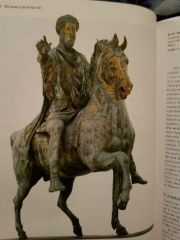
|
EQUESTRIAN STATUE OF MARCUS AURELIUS C. 176 CE Th High Imperial Art of Trajan and Hadrian Bronze coated in gold 11'6c" Avoided melting because Christians mistakenly thought it was Constantine Imperial honor, stance Outstretched hand and eye contact signifies fairness to his people Large stallion controlled easily conveys power and strength
|
|
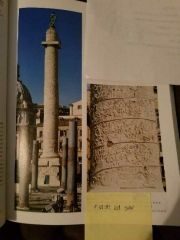
|
COLUMN OF TRAJAN Th High Imperial Art of Trajan and Hadrian Rome Romans crossing the Danube and building a fort The spiral relief carvings resemble scrolls Part of library |
|
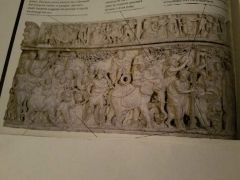
|
SARCOPHAGUS WITH THE INDIAN TRIUMPH OF DIONYSUS Th High Imperial Art of Trajan and Hadrian Marble 47.5x92.5x36" Roman sarcophagus High relief Roman transition |
|

|
THE TETRARCHS The Late Empire Porphyry (purple stone) 51" Leaders in Rome that shared power Keep enemies close |
|

|
ARCH OF CONSTANTINE The Late Empire Rome 3 arches Systematically got rid of tetrarchs to become sole ruler Moved Roman capital to Greek city Byzantium, ancient city where Europe and Asia meet, renames city Constantinople, lasts 1000 yrs, Turks rename it Istanbul Legalized mystery cults and promoted Christianity Tondi (circles) and Frieze done by different artists, conglomerate of old emperor are, inspired nostalgia to gain favor of the ppl |
|
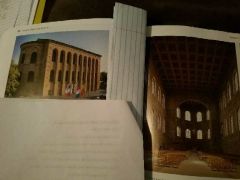
|
BASILLICA OF MAXENITUS AND CONSTANTINE The Late Empire Rome Each emperor had one, each better than previous one Each city had one, necessary for gov Different size windows create depth Last imperial structure to be built in Rome Apse and audience HALL Turned into church |
|
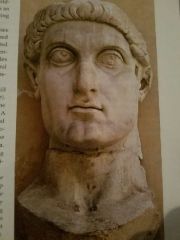
|
HEAD OF CONSTANTINE THE GREAT C.325-315CE Marble 8'6" Legally represented presence of Constantine for legal proceedings |
|
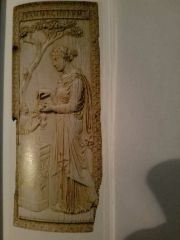
|
PRIESTESS CONDUCTING THE RITES OF BACCHUS C 390- 401 CE Ivory 11.75x4.75" Shows allegiance to old ways and gods Ornate detailed carving Last dying gasp of a world fading away |

